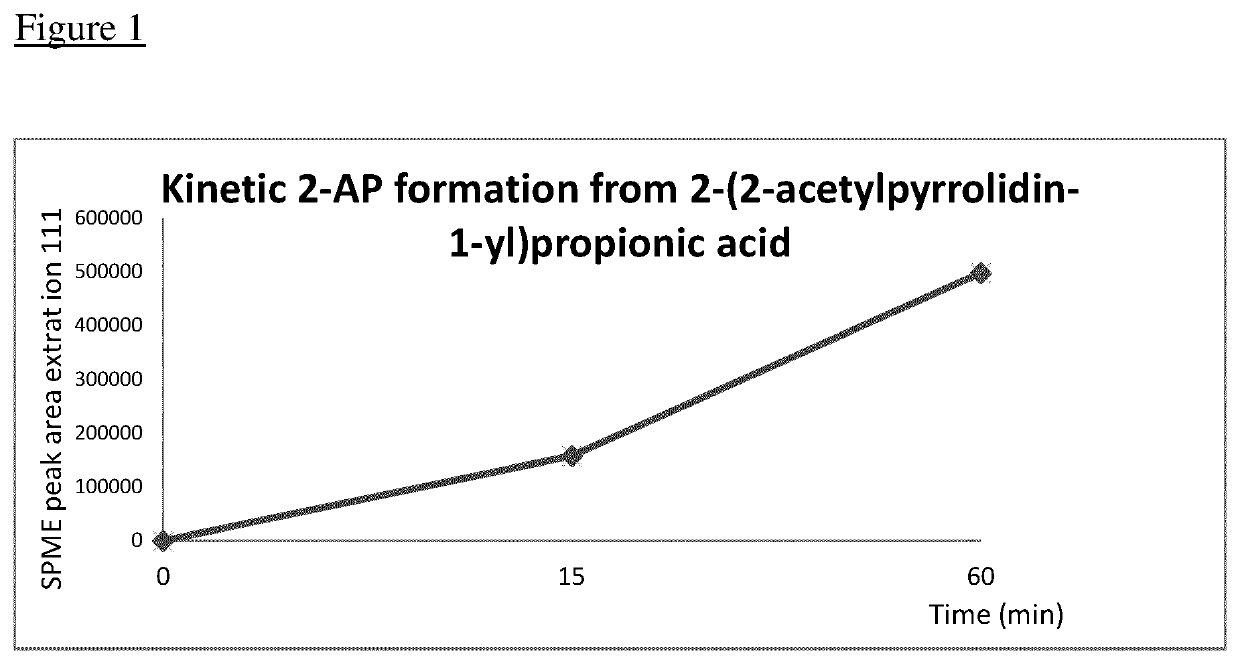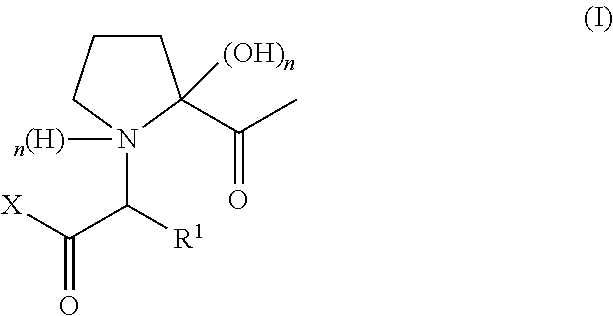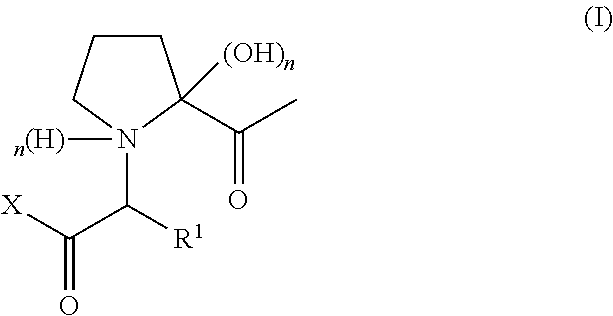2-acetylpyrroline precursor
- Summary
- Abstract
- Description
- Claims
- Application Information
AI Technical Summary
Benefits of technology
Problems solved by technology
Method used
Image
Examples
example 1
Preparation of Compounds of Formula (I)
[0094]a) Preparation of 4,5-dioxohexanal
[0095]2-Methylcyclopent-2-en-1-one (9 g, 93 mol) in CH2Cl2 (250 mL) was cooled with dry ice and isopropanol at −78° C. in a dedicated ozonolysis flask. Ozone was bubbled through (3.8 g / h) for 80 min (5 g, 102 mol). The gas at the outlet was bubbled in a trap containing KI saturated solution. When the KI solution turned dark, N2 was then bubbled through the reaction mixture to flush out excess ozone. Dimethyl sulfide (DMSO) (27 mL) was added and the mixture was slowly warmed at 22° C. for 3 h. The organic phase was washed with brine, dried on Na2SO4, and then concentrated to 25 mL. The 4,5-dioxohexanal was kept at −18° C. For the reactions, the solvent was removed just prior to use. 13C NMR (150 MHz, DMSO): d 23.4 (q), 27.8 (t), 36.7 (t), 196.5 (s), 197.2 (s), 201.9 (d).
[0096]1H NMR (600 MHz, DMSO): δ 2.24 (s, 3H), 2.70 (m, 2H), 2.95 (t, 6.6 Hz, 2H), 9.66 (t, 0.7 Hz, 1H).
[0097]b) Preparation of Compound of...
example 2
[0118]Thermal Release of 2-acetylpyrroline
[0119]10 mg of 2-(2-acetylpyrrolidin-1-yl)propanoic acid prepared in example 1 was dissolved in water (2 mL) containing 5 mg NaHCO3 and heated for 60 min at 120° C. in a heating block. The release kinetics was measured as mentioned below.
[0120]A calibrations curve was done with water (6 mL), 10 μL of toluene and lutidine (50 μL of a solution 1 mg / mL EtOH), then vial 1 to 4 contained respectively, instead of toluene, 2-AP in toluene, respectively 10 μL of 50, 100, 500, 1000 μg / mL. All measurements were made in triplicate. The SPME conditions were: 5 min. conditioning at 270° C., the exposure was 3 min after having heated the sample at 120° C. during 15 min and then 60 min. The thermo-desorption, in split less mode, was 1.5 min at 250° C. The quantification was performed in full MS based on the intensity ratio in extract ion mode: 111 (2-AP) / 107 (lutidine). The pH was in any case between 6.5-7.0. The standard error was ±16%.
[0121]The release o...
PUM
 Login to View More
Login to View More Abstract
Description
Claims
Application Information
 Login to View More
Login to View More - R&D
- Intellectual Property
- Life Sciences
- Materials
- Tech Scout
- Unparalleled Data Quality
- Higher Quality Content
- 60% Fewer Hallucinations
Browse by: Latest US Patents, China's latest patents, Technical Efficacy Thesaurus, Application Domain, Technology Topic, Popular Technical Reports.
© 2025 PatSnap. All rights reserved.Legal|Privacy policy|Modern Slavery Act Transparency Statement|Sitemap|About US| Contact US: help@patsnap.com



